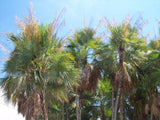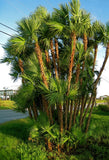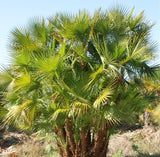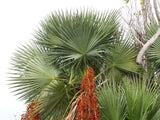Paurotis Palm (Acoelorraphe wrightii) Seeds – Whispered Echoes of the Everglades
Step into a realm where gentle breezes carry the memory of ancient swamps, where emerald fans unfurl like nature’s own umbrellas—this is the magic of Acoelorraphe wrightii, the Paurotis Palm, brought to life from tiny seed to lush clumped palms.
Bloom & Growth
Plant your seeds with care and watch, in late winter to early spring, slender trunks rise supporting sweeping fan-shaped fronds—light green above, shimmering silver underneath—topped by creamy white or creamy-yellow blooms that boldly extend beyond the foliage. By summer, vivid golden-orange to black drupes dangle, turning your palms into living lanterns of seasonal color.
Hardiness & Conditions
These palm seeds carry the promise of resilience. Hardy within USDA Zones 9A through 11 (some sources note zones 9–12), with the most robust success in Zones 10–11. While tropical at heart, they’ve even rebounded from freezes well into the high teens°F—some plants in Zone 9a revived from a daring 13°F drop, a testament to their tenacious spirit.
Ecology & Wildlife Magic
Far more than a decorative wonder, this palm is a haven for wildlife: local birds delight in its fruit, spreading the seeds on feathered wings; buzzing bees are also drawn to its blossoms, contributing to the hum of wetland life. While no record links it to specific butterfly or moth larvae, its role as a food source and cover for birds and beneficial insects remains a heartbeat in its ecological story.
Cultural Echoes & Ethnobotany
Named in honor of the intrepid botanist Charles Wright, this palm’s genus evokes growth—“without hollow needle”—a poetic nod to its distinctive fruit form. Its fibrous leaves once draped as thatch, woven into baskets or hats; even salt was extracted from its core, and trunks served as climbing supports in Cuban nurseries. Dense clumps once dotted the Everglades, rising like green islands amid the “river of grass”. Today, wild specimens are safeguarded by Florida law, their legacy preserved in cultivated groves born from responsibly sourced seeds.
Interesting Tidbits
-
For decades, the palm’s name was misspelled in cultivation—choosing between Acoelorrhaphe or Acoelorraphe—reminding botanists that even names can be an adventure.
-
Despite its slender, delicate appearance, its clusters persist through hurricanes, providing refuge amid chaos.
-
Its slow growth ensures that, once established, you steward a living tapestry that matures richly over years—worth every moment of patient nurturing.
Product Highlight: Acoelorraphe wrightii Seeds—Living Heritage in Every Grain
-
Hardiness: USDA Zones 9A–11 (some sources 9–12); exceptional freeze resilience.
-
Bloom Color: Creamy white to creamy yellow in spring.
-
Ecological Role: Supports birds (fruit dispersal) and bees (pollination).
-
Cultural Significance: Used for weaving, salt, roofing, and basketry; a Florida Everglades native now protected and celebrated.
-
Fun Facts: Survived historic freezes; once misnamed; fans carry a silvery whisper.
Planting Tip: Sow your seeds in moist, slightly acidic sandy or loamy soil, mimicking swamplands. Offer partial to full sun. Keep water close, especially during germination—the roots crave moisture, just like their native home.
Each seed is a little promise: to bring ancient wetlands into your garden, to host buzzing bees, to echo human craftsmanship, and to stand tall, graceful, and enduring.
May your Paurotis Palm grow into a fragrant pillar of beauty, resilience, and storytelling.










